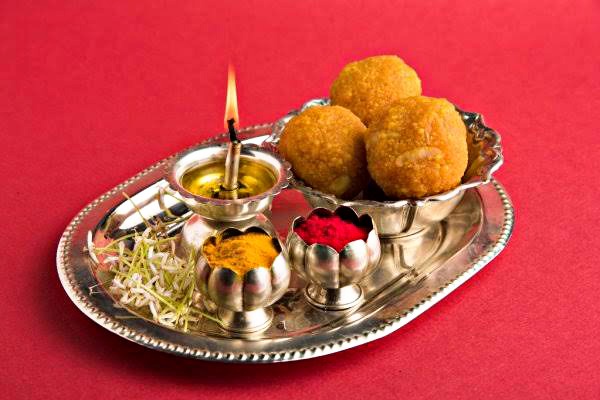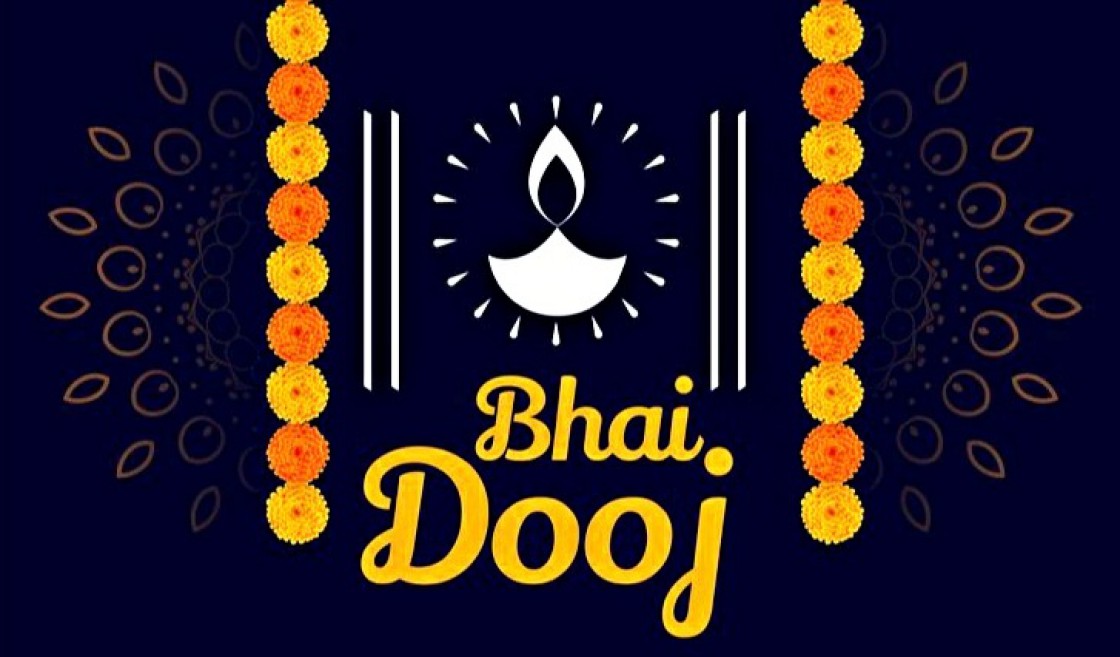There is a unique understanding between a brother & a sister. They share an amazing bond of best friends, admirers, secret sharers & has unconditional love for each other. It is difficult to explain the feelings, emotions & love of siblings in words. However, in Hinduism there are special days or occasions that are dedicated for strengthening the love between a brother & a sister. Bhai Dooj (भ्रातृ द्वितीया) is one such occasion that can define the eternal love between brother & sister which prolong their intact connection & make it more intense. This wonderful festival is an important occasion where sisters pray to God for the longevity, well-being & prosperity of their beloved brothers.
This festival occurs after two days of the Diwali festival & next to Gujarati new year (Bestu Varsh) (બેસતું વર્ષ) / Govardhan Puja. According to the Hindu calendar, the occasion occurs on the 2nd day of the bright fortnight of the Kartika month (कार्तिकः शुक्लपक्षे ०२) of Hindu Calendar which generally falls between October & November in Georgian calendar. The festival of Bhai Dooj (भ्रातृ द्वितीया) has a literal meaning attached to it. It is a combined two words namely- “Bhai” which means brother & “Dooj” literally means the second day. Bhratru Dwitiya (भ्रातृ द्वितीया) is the Sanskrit name for Bhai Dooj where “भ्रातृ” means Brother & “द्वितीया” means the second day.
This day is celebrated in different states of India with different names in different cultures, regions & language with different rituals. List of the same is given below;
- In the entire Northern part of India it is known by the name “Bhai Dooj” (Hindi: भाई दूज) & it is widely celebrated by Awadhis in Uttar Pradesh.
- In Bengal it is known by the name “Bhai Phonta” & it is mainly observed in West Bengal, Assam, Tripura, Bangladesh.
- In most of the Southern parts of India it is known by the name “Bhatru Dwitiya” or “Bhaghini Hastha Bhojanamu” in Andhra Pradesh, Telangana & some parts of Tamil Nadu.
- Amongst the Marathi & Konkani speaking communities, mostly in the states of Maharashtra, Goa & Karnataka it is known by the name “Bhau Beej” (भाऊबीज) or “Bhav Bij”. Apart from marking red dot (तिलकम्) on the forehead & waving lamps (आरार्तिकम्) (Aarti), they make basundi puri or sikarkand puri to celebrate this day.
- Amongst the Gujarati speaking community, in the state of Gujarat it is known by the Name “Bhai Beej” (ભાઈ બીજ) & it is celebrated by inviting brothers at home & offering sweets & special dishes to the brothers.
- In Haryana it is known by the name “Bhaiya Dooj”. A special ritual is also followed by them like, tying dry coconut with a thread & using it while waving lamps (आरार्तिकम्) to the brothers.
- In Nepal it is known by the name “Bhai Tika” (भाई टीका). It is widely celebrated by the Khas people. They celebrate it by applying a colourful mark (तिलकम्) on forehead, which consists of seven colours which is famously known as ‘Saptarangi Tika’ in Nepali language. This is considered as the most important festival in Nepal.
- In Some southern part of India, it is known by the name “Yama Dwitiya” (यम द्वितीया).
- In western Odisha it is known by the name “Bhai Jiuntia”. This festival is not celebrated in Kartika month but it is celebrated in the month of Ashvina on the 8th day of the bright fortnight (अश्विनः शुक्लपक्षे ०८) where the rituals & concepts are almost same.

Historical account of Bhai Dooj (भ्रातृ द्वितीया) -
The most famous & primary name of this day is “Yama Dwitiya” (यम द्वितीया). There is a historical account revolves around the story of Lord Yama (the God of Death) & his sister Goddess River Yamuna. According to the Bhavishyottara Purana (भविष्योत्तरपुराणम्), Lord Yama & Goddess River Yamuna are the children of Lord Surya (the Sun). Goddess Yamuna invited her brother Lord Yama to her house many times but, Lord Yama was unable to visit her house as he was engaged in the management of Yamaloka (यमलोकः) (an abode of Yama). At last, he took some time out from his busy schedule & went to his sister Yamuna’s house. Goddess Yamuna got over-whelmed to see her brother. She showed great respect to her brother by applying a mark (तिलकम्) on her brother Yama’s forehead, garlanded him & offered him different kinds of sweets & special dishes that she cooked herself. Lord Yama was very much pleased by her sister’s hospitality so, he asked Goddess Yamuna to choose a boon. Goddess Yamuna requested to offer a boon that, those brothers & sisters who take a dip in holy Yamuna River & brothers who visit their sister's house & consume food prepared by her on this day (i.e., second day of bright fortnight of Kartika month) will never attain Hell (नरकम्). Lord Yama agreed & also promised that sister who invites her brother & serves food to him on this day, will never become a widow.
Since then, the tradition & ritual of this day began. Hence, a holy dip in the Yamuna on this day is of great significance & because it is connected to Lord Yama (God of death), he is also worshipped on this festival. Sisters pray for the well-being, good health & prosperity of their brothers. It is also mentioned in the Puranas that, if brother doesn’t have a sibling sister than he should visit his cousin sister’s house & if a sister doesn’t have sibling brother than she should invite her cousin brother to her house. As Lord Yama (God of Death) met his beloved sister on the second day of the bright fortnight of Kartika month (कार्तिकः शुक्लपक्षे ०२), this day began to be celebrated as Yama Dwitiya (यम द्वितीया) across the country since that day.
There is another Historical account of Lord Krishna & his sister Subhadra. According to the Puranas, on this day, Lord Krishna visited his sister Subhadra after killing demon Narkasur. His sister Subhadra gave a warm welcome to him by applying a mark (तिलकम्) on Lord Krishna’s forehead, garlanded him & offered different sweets & special dishes. Since that day, the ritual began of worshipping for the wellbeing of brothers by sisters hence this day became famous by the name Bhratru Dwitiya (भ्रातृ द्वितीया).

The Ritual Ceremony of Bhai Dooj (भ्रातृ द्वितीया) -
This day is celebrated as different tradition in different states of India. On this day, according to some states where the River Yamuna flows (i.e., Uttarakhand, Himachal Pradesh, Haryana, Uttar Pradesh, Delhi, etc.), brothers & sisters take a bath in Yamuna River after which they worship Lord Ganesha, Goddess Yamuna, Lord Yama (God of Death) & later; after finishing the puja ritual, sister wash the feet of her brother & apply a red mark (तिलकम्) on his forehead, wave the lamp (आरार्तिकम्) (Aarti) in front of her brother. After that, she offers different sweets & special dishes made by her to her brother & she prays for the long, healthy & prosperous life of her brother & in return as per the capacity, a brother offers grains / clothes / gold ornaments, etc.
According to the other tradition, brother sister does not take a bath in Yamuna River neither they organize puja ritual of Lord Yama (God of Death) & Goddess Yamuna. Instead, brother visits his sister’s house, Sisters waves lamps (आरार्तिकम्) (Aarti) in front of brother & apply a red mark (तिलकम्) on his forehead & if the brother is older, sister touches her brother’s feet & seek blessings. She prays for the long, healthy & prosperous life of her brother & offers different sweets & special dishes made by her. In return brother offers blessings with some gifts.
Thus, this festival signifies the love, faith & respect between brothers & sisters. As sisters prays for long & healthy life of her brother, brothers bless his sister for the same & promises her to protect her from every situation.
ज्येष्ठः शुक्लपक्षे ०४, २०७७
